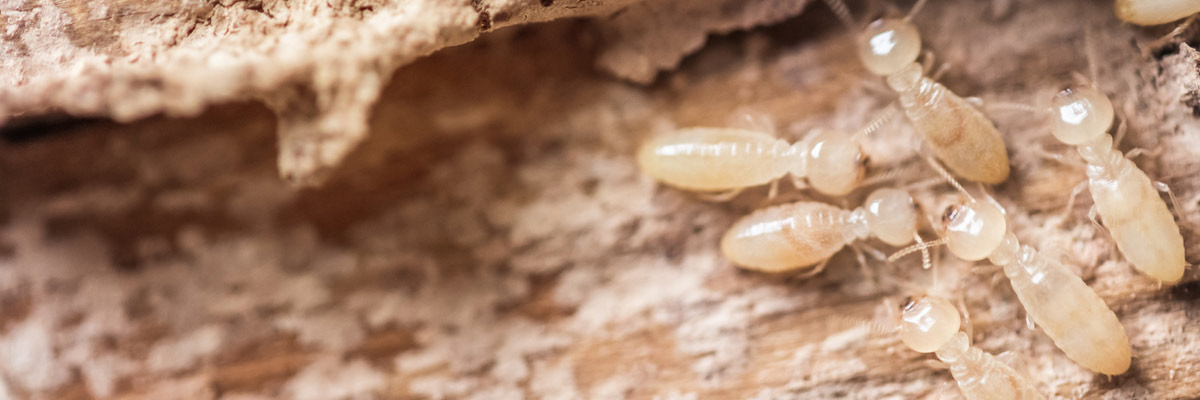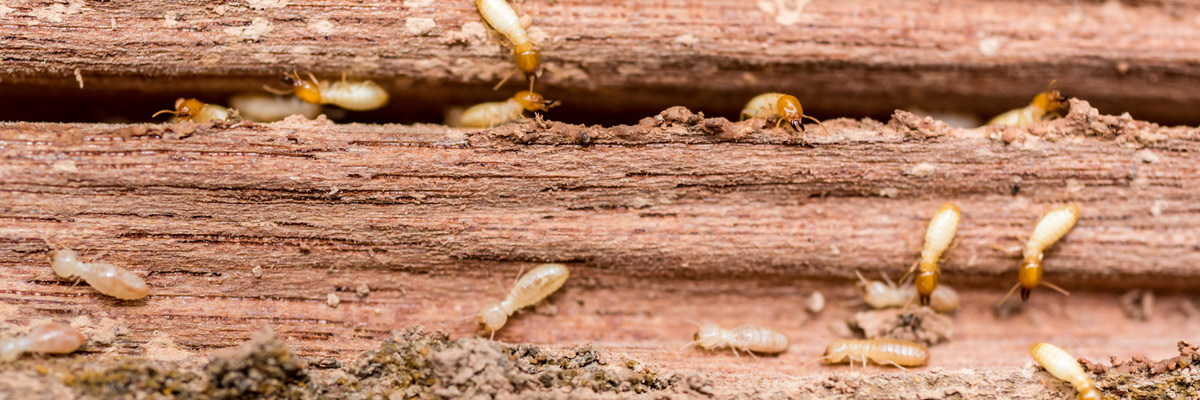Types of Termite Control that Can Protect Your Home
Termites are one of the biggest pest problems for homeowners in the U.S. As close relatives to cockroaches, they are just as unsettling and substantially more damaging to have in your home. These mites reproduce quickly and survive off eating wood – slowly breaking down foundations and costing upwards of billions in global damage. Unfortunately, home insurance doesn’t always protect from termite damage, and homeowners could be stuck footing a bill worth thousands of dollars.
Termites are usually only 10 mm in length, allowing them to sneak undetected into homes. Depending on the species, termites are attracted to different environments. Some need moist wood, while others prefer dry wood. The geography and landscape around your home will determine the type of termites you’re vulnerable to. Once inside, they’ll build their nests either in the ground or within the wood foundation and begin to develop their colony. After a couple of years of reproduction, a colony could contain up to one million termites, creating extensive tunnels of hidden damage.
How Do I Know If I Have Termites?
Termites are difficult to identify because of their hidden nests and damage. If you think you have an infestation, there are a couple of things to look for. Keep in mind that you should contact a professional to get their expert opinion as well.
The first thing you can do is check your wood. Some species of termites will leave piles of shredded wood where they’ve tunneled close to the surface. If there isn’t any visible damage, you can also knock on the wood. If it sounds hollow, there’s a good chance termites have eaten through the inside of the wood.
You should also keep an eye out for swarmers. These are winged termites that tend to group near the ground or light sources. They discard their wings at a certain point in their lifecycle, so you may also see these scattered around the floor if you have an infestation.
Is Termite Control Necessary?
Termite control is absolutely necessary both before and after an infestation. Prevention is always easier than extermination. Luckily, most new homes are built with pretreats. These pre-construction treatments to wood ensure safeguarding from termites. This can include liquid termiticides coated on the wood or physical barriers underground, such as gravel, plastic, or wire.
If your home doesn’t have pre-treatments, you’ll have to use extermination methods to control an infestation. Liquid termiticides, gas, heat, and other methods are either used as complete or partial treatments. Complete treatments are used for large, widespread infestations while partial spot treatments can be effective when termites are only in one area of the home or have a smaller colony.
Termite control should be a priority in your home to ensure its safety and protection for years to come. By taking proper precautions and understanding the signs of a termite infestation, you can significantly mitigate the damage and potential cost. Though it can be hard to get rid of termites, an experienced professional will use the method that’s best for your home.

It’s easy to find providers in your area
Searching with your zipcode will provide you with local pest control services.
Types of Termites
There are a couple of different species of termites to be aware of. They’re drawn to different geographies, climates, and types of wood. Understanding their behavior is the first step toward adequately identifying any termite infestation.
Drywood Termites
True to their name, drywood termites are in search of dry wood that they can ingest and burrow into to make nests. They’re commonly found as east as Florida and throughout the Southern U.S. While other species of termites are in search of additional water sources, these termites get all the water they need through the air and wood they eat. Because of this, they don’t need to stay close to the ground. These termites enter the home through a separate wood source, such as a piece of furniture or decaying wood like a tree stump or branch. A drywood termite infestation could be widespread throughout your home. As they tunnel from the inside out, you may see remnants of their damage in the form of wood pilings.
Dampwood Termites
Unlike drywood termites, dampwood termites stay close to the ground and seek out moist, decaying wood as their food source. To prevent against dampwood termites, you should ensure your landscaping is designed to avoid as much moisture around your house as possible. Any pooling could soften the wood in your foundation and attract dampwood termites. Similar to drywood termites, they create their nests in wood but don’t leave many signs of their damage. Instead of leaving behind wood pilings or evidence of their tunnels, they plug the wood to maintain its humidity. This makes dampwood termites some of the hardest to detect. If you live in damp Western states, you should take precautions against dampwood termites and hire professionals who can complete termite inspections.
Subterranean Termites
Subterranean termites are the most common species. They’re found in every state in the United States except Alaska. Similar to dampwood termites, it’s more challenging to detect subterranean termite activity. This species live underground and create a network of tunnels that extends up into the homes they live underneath. Subterranean termites will cause extensive damage to home foundations because of their proximity to the ground. To prevent against subterranean termites, you should take all of the necessary precautions that protect against other species. Make sure your home has proper drainage to reduce the amount of moisture in the soil, and any wood or vegetation around your home should be adequately cared for or moved away. A pest management professional can conduct annual inspections to identify an infestation at its start instead of letting the termite colony to cause extensive damage.

Methods of Termite Treatment
When you’re facing a termite infestation, a pest control professional can use a variety of methods to get rid of the problem. The severity of the infestation, the size of the colony, the damage, and the type of home will all determine the best treatment to use.
Non-Chemical Methods
Non-chemical termite treatments are best used as prevention methods or when the termite colony is still small. These methods can include physical barriers, damage removal, and moisture control.
Physical Barriers
Physical barriers like steel mesh and sands are often put in place as the home is being constructed. These products form a block between the soil and your foundation to force termites to look elsewhere for food.
Damage Removal
If you have a localized termite infestation, professionals may be able to remove the wood with existing termite damage and replace it with new wood. This can eliminate the infestation, but additional prevention methods will be required to ensure more termites don’t come back.
Moisture Removal
Moisture removal is one of the easiest ways to prevent against termites or ensure that the habitat surrounding your home becomes inhabitable for certain species. Moisture removal will require both plumbing and landscaping to make sure your home isn’t creating excess moisture.
Heat Treatment
Another non-chemical treatment method is heat treatment. Separate from the methods mentioned above, heat methods are usually used for an extensive infestation rather than for a small colony or prevention. With a heat treatment, high temperatures up to 140 degrees Fahrenheit is used to kill off termites in targeted areas throughout your home.
Chemical Methods
Chemical treatment methods come in a variety of forms to kill off colonies of termites. These treatments use potent pesticides that are certified to be effective on termites yet safe for you and your family.
Bait Stations
Termite bait systems are a standard tool that can be placed throughout your home to kill off termites. A pest control professional will place these stations at several access points near the colony’s nest. Each station will contain a chemical that is both appealing and lethal to termites. The termites will take the bait thinking it is food and bring it back to the rest of the colony, where it will spread and kill them as it is ingested.
Gas Fumigation
Gas fumigation is an excellent option to use against drywood termites since their tunnels tend to be more widespread throughout homes. Though the chemicals used won’t be dangerous to your home after treatment, gas fumigation does require you to vacate the premises as it’s being used. The gas chemicals will permeate throughout your home to reach termites in all their locations and kill them after they breathe in the chemicals.
Termiticide
Termiticide is poison to termites and kills them quickly and effectively. Pest management companies will often use the chemical in spray form and make sure it’s applied to any affected area of wood. When used correctly, these chemicals are not dangerous to you or your family. However, they can be extremely harmful if they’re used inappropriately. With any treatment method, make sure you’re consulting with a trained exterminator to ensure the chemicals are being used as safely as possible.
Soil Treatment
Since subterranean and dampwood termites reside in or near the ground, treating your soil is key to full termite control. With soil treatments, chemicals are strategically placed into the soil through liquid termiticide trenches. This will kill off subterranean termites living underground and prevent dampwood termites from appearing underneath your home.
Wood Treatment
Unlike the methods listed above, wood treatments are a chemical method used to prevent an infestation rather than get rid of one. These pre-treatments use a chemical called borates, which makes the wood in your home uninhabitable and indigestible to termites. The borates are sprayed onto the wood before it is used to build a house.
DIY Termite Control
If you’re asking how to treat termites, you may be wondering if you can do it yourself. When it comes to DIY termite control, there are many prevention methods you can do on your own, but treatment methods are much harder and dangerous to attempt without a professional.
Though there are plenty of termiticides available to purchase in stores, a full-blown infestation will need additional equipment and extensive use of chemicals. You should always consult a professional if you’re dealing with a large termite infestation and any damage to your home.
For prevention, store-bought chemicals and natural pesticides can be applied to the soil around your home without professional help. Though physical barriers are known to be more successful, these preventative measures could help deter termites from making a home.

Termite Prevention
Preventing termites is much more budget-friendly, safe, and easy compared to treating an infestation. The biggest thing you can do is continually inspect your home to make sure the habitat is unsuitable for termites. With continual inspections, you should also look for signs of termites to catch a colony before it gets too big and causes extensive damage.
Make sure your plumbing is working as efficiently as possible and there aren’t any leaks leading toward the ground or outside your home. You should also make sure the landscape around your home is designed to prevent pooling or additional moisture on the ground.
Always keep an eye out for the signs of a termite infestation, such as hollowed wood, wood pilings, termite wings, or swarmers. At the first site of termites, you should work with a professional to determine the best methods of treatment.
